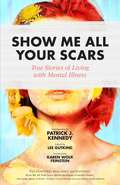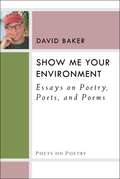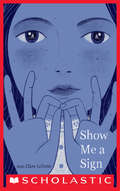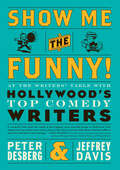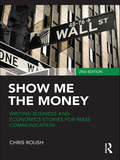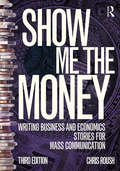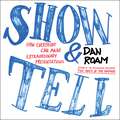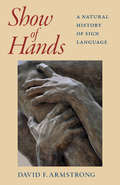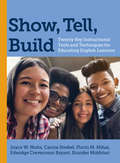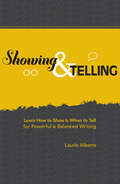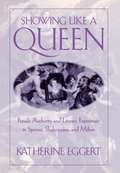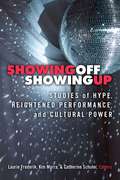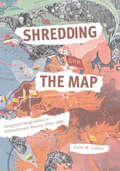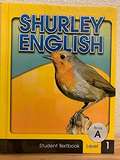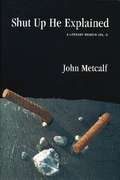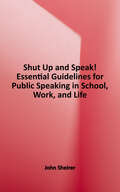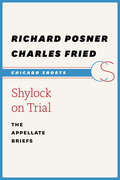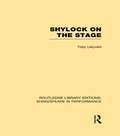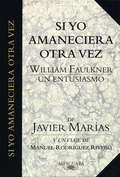- Table View
- List View
Show Me All Your Scars: True Stories of Living with Mental Illness
by Lee Gutkind Patrick J. Kennedy Dr Karen Wolk FeinsteinEvery year, one in four American adults suffers from a diagnosable mental health disorder. In these true stories, writers and their loved ones struggle as their worlds are upended. What do you do when your father kills himself, or your mother is committed to a psych ward, or your daughter starts hearing voices telling her to harm herself-or when you yourself hear such voices? Addressing bipolar disorder, OCD, trichillomania, self-harm, PTSD, and other diagnoses, these stories vividly depict the difficulties and sorrows-and sometimes, too, the unexpected and surprising rewards-of living with mental illness.
Show Me Your Environment: Essays On Poetry, Poets, And Poems
by David BakerShow Me Your Environment, a penetrating yet personable collection of critical essays, David Baker explores how a poem works, how a poet thinks, and how the art of poetry has evolved—and is still evolving as a highly diverse, spacious, and inclusive art form. The opening essays offer contemplations on the “environment of poetry from thoughts on physical places and regions as well as the inner aesthetic environment. Next, he looks at the highly distinctive achievements and styles of poets ranging from George Herbert and Emily Dickinson through poets writing today. Finally, Baker takes joy in reading individual poems—from the canonical to the contemporary; simply and closely.
Show Me a Sign
by Ann Clare LeZotteMary Lambert has always felt safe and protected on her beloved island of Martha's Vineyard. Her great-great-grandfather was an early English settler and the first deaf islander. Now, over a hundred years later, many people there -- including Mary -- are deaf, and nearly everyone can communicate in sign language. Mary has never felt isolated. She is proud of her lineage. <P><P>But recent events have delivered winds of change. Mary's brother died, leaving her family shattered. Tensions over land disputes are mounting between English settlers and the Wampanoag people. And a cunning young scientist has arrived, hoping to discover the origin of the island's prevalent deafness. His maniacal drive to find answers soon renders Mary a "live specimen" in a cruel experiment. Her struggle to save herself is at the core of this penetrating and poignant novel that probes our perceptions of ability and disability. It will make you forever question your own ideas about what is normal.
Show Me the Funny!: At the Writers' Table with Hollywoods Top Comedy Writers
by Jeffrey Davis Peter DesbergEnjoy a unique glimpse into the intelligent and quirky inner workings of the comedic mind! This special e-version of Show Me the Funny! presents 28 top comedy screenwriters--including three bonus interviews not in the original print book--from the revered figures of televisions “Golden Age” to todays favorite movie jokesters. Authors Desberg and Davis put an innovative spin on the traditional interview: each writer was given the same loosely structured comedic premise and asked to develop it in any way he or she wanted-no rules, no boundaries, no limits! The result is a hilarious and illuminating look at the comic process. INCLUDES:o Leonard Stern (co-creator of Get Smart) o Sherwood Schwartz (Gilligans Island, The Brady Bunch) o Peter Casey (co-creator of The Jeffersons, Cheers, Wings, Frasier) o Phil Rosenthal (co-creator of Everybody Loves Raymond) o Ed Decter (co-writer of Theres Something About Mary) o plus three e-book only interviews: Marley Simms (Home Improvement, Sabrina the Teenage Witch)Dan O’Shannon (Modern Family, Frasier, Cheers), and Charlie Hauck (Maude, Cheers)
Show Me the Money: Writing Business and Economics Stories for Mass Communication
by Chris RoushShow Me the Money is the definitive business journalism textbook that offers hands-on advice and examples on doing the job of a business journalist. Author Chris Roush draws on his experience as a business journalist and educator to explain how to cover businesses, industries and the economy, as well as where to find sources of information for stories. He demonstrates clearly how reporters take financial information and turn it into relevant facts that explain a topic to readers. This definitive business journalism text: provides real-world examples of business articles presents complex topics in a form easy to read and understand offers examples of where to find news stories in SEC filings gives comprehensive explanations and reviews of corporate financial, balance sheet, and cash flow statements provides tips on finding sources, such as corporate investors and hard-to-find corporate documents gives a comprehensive listing of websites for business journalists to use. Key updates for the second edition include: tips from professional business journalists provided throughout the text new chapters on personal finance reporting and covering specific business beats expanded coverage of real estate reporting updates throughout to reflect significant changes in SEC, finance, and economics industries. With numerous examples of documents and stories in the text, Show Me the Money is an essential guide for students and practitioners doing business journalism.
Show Me the Money: Writing Business and Economics Stories for Mass Communication (Routledge Communication Series)
by Chris RoushShow Me the Money is the definitive business journalism textbook that offers hands-on advice and insights into the job of a business journalist. Chris Roush draws on his experience as both a business journalist and educator to explain how to cover businesses, industry and the economy, as well as where to find sources of information for stories and how to take financial information and make it work for a story. Updates to the third edition include: Inclusion of timely issues related to real estate; Additional examples from websites and other nontraditional business media such as BuzzFeed and Quartz; Tips from professional business journalists including Andrew Ross Sorkin of The New York Times and Jennifer Forsyth of The Wall Street Journal. Essential for both undergraduate and graduate courses in business journalism and professional business journalism newsrooms, Show Me the Money is a must-read for reporters, editors and students who want to learn the ins and outs of how to cover public and private companies. Additional materieals, including a sample syllabus and additional links and tips for students can be found at https://www.routledge.com/products/9781138188389
Show Your Tongue
by Günter Grass John E. WoodsA record of the author's stay in Calcutta from August 1987 to January 1988. A stunning document in Grass's own words and drawings.
Show and Tell: How Everybody Can Make Extraordinary Presentations
by Dan Roam“If I tell you the truth, if I tell it with a story, and if I tell that story with pictures, I can keep you glued to your seat. Let me show you how.”For the vast majority of us, giving a presentation is an extremely difficult and nerve-wracking process, whether we’re in a one-on-one meeting, a conference room with a dozen strangers, or a lecture hall in front of thousands.But according to Dan Roam, the visual communications expert and acclaimed author of The Back of the Napkin, it doesn’t have to be so hard. We struggle when we forget the basic steps we learned in kindergarten: show and tell.In this short but powerful book, Roam introduces a new set of tools for making extraordinary presentations in any setting. He also draws on ideas he’s been honing for more than two decades, as an award-winning presenter who has brought his whiteboard everywhere from Fortune 500 companies to tiny startups to the White House.Even if you’re already a good speaker, you’ll learn more about understanding your audience, organizing your content, building a clear storyline, creating effective visuals, and channeling your fear into fun. And you’ll master three fundamental rules:• When we tell the truth, we connect with our audience, we become passionate, and we find self-confidence.• When we tell a story, we make complex concepts clear, we make ideas unforgettable, and we include everyone.• When we use pictures, people see exactly what we mean, we captivate our audience’s mind, and we banish boredom.From nailing the opening to leaving a lasting impression, you’ll soon be able to give the performance of a lifetime . . . time after time.PLEASE NOTE: This eBook edition of SHOW AND TELL is carefully laid out to match the print book; this means it reads much better as designed pages, but you won't be able to use some features such as highlighting and annotating text.
Show of Hands: A Natural History of Sign Language
by David F. ArmstrongMost scholarly speculation on the origin of human language has centered around speech. However, the growing understanding of sign languages on human development has transformed the debate on language evolution. David F. Armstrong's new book Show of Hands: A Natural History of Sign Language casts a wide net in history and geography to explain how these visible languages have enriched human culture in general and how their study has expanded knowledge of the human condition. Armstrong addresses the major theories of language evolution, including Noam Chomsky's thesis of an innate human "organ" for language and Steven Pinker's contention that there is language and not-language without any gradations between gesture and language. This engrossing survey proceeds with William C. Stokoe's revival of the early anthropological cognitive-linguistic model of gradual development through the iconicity of sign languages. Armstrong ranges far to reveal the nature of sign languages, from the anatomy of early human ancestors to telling passages by Shakespeare, Dickens, and Pound, to the astute observations of Socrates, Lucretius, and Abbé de l'Epée on sign communication among deaf people. Show of Hands illustrates the remarkable development of sign languages in isolated Bedouin communities and among Australian indigenous peoples. It also explores the ubiquitous benefits of "Deaf Gain" and visual communication as they dovetail with the Internet and its mushrooming potential for the future.
Show, Tell, Build: Twenty Key Instructional Tools and Techniques for Educating English Learners
by Joyce W. Nutta Kouider Mokhtari Carine Strebel Florin M. Mihai Edwidge Crevecoeur BryantBuilding upon the theoretical and practical foundation outlined in their previous book, Educating English Learners, the authors show classroom teachers how to develop a repertoire of instructional techniques that address K–12 English learners (ELs) at different English proficiency and grade levels, and across subject areas. Show, Tell, Build is organized around two decision maps for planning and implementing differentiated instruction for ELs: the Academic Subjects Protocol (for teachers of academic subjects) and the Language Arts Protocol (for teachers of language arts). The instructional tools and techniques described in each chapter help teachers provide communication support for ELs through showing and telling, and develop their language proficiency through building their skills. The book also discusses the demands that academic language poses for ELs and ways to assess students&’ proficiency in English. Show, Tell, Build provides classroom teachers, English language development specialists, literacy coaches, and school leaders with valuable knowledge and skills to support ELs&’ academic success.
Showing & Telling: Learn How to Show & When to Tell for Powerful & Balanced Writing
by Laurie AlbertsWrite vibrant scenes and essential summaries "Show#151;don't tell. " How many times have you heard this standard bit of writing advice? It's so common in writing courses and critiques that it has become a cliche. Writers are often told to write scenes, dramatize, cut exposition, cut summary#151;but it's misguided advice. The truth is good writing almost always requires both showing and telling. The trick is finding the right balance of scene and summary#151;the two basic components of creative prose. Showing and Tellingshows you how to employ each of these essential techniques in the appropriate places within a narrative. You'll learn how to: Write scenes and cut exposition Compress time and summarize background information Create graceful transitions Effectively inject interpretation And more! Complete with examples from bestsellers and interactive exercises, this comprehensive guide offers an in-depth look at scene development, the role of reflection in storytelling, the art of summarizing, and how to bring it all together.
Showing Like a Queen: Female Authority and Literary Experiment in Spenser, Shakespeare, and Milton
by Katherine EggertFor most Renaissance English thinkers, queenship was a catastrophe, a political accident that threatened to emasculate an entire nation. But some English poets and playwrights proved more inventive in their responses to female authority. In Showing Like a Queen, Katherine Eggert argues that Spenser, Shakespeare, and Milton turned the political problem of queenship to their advantage by using it as an occasion to experiment with new literary genres. Unlike other critics who have argued that a queen provoked only anxiety and defensiveness in her male subjects, Eggert demonstrates that even after her death Elizabeth I's forty-five-year reign enabled writers to entertain the fantasy of a counterpatriarchal realm.Eggert traces a literary history of the late sixteenth and early seventeenth centuries in which the destabilizing anomaly of female rule enables Spenser to reshape the genre of epic romance and gives Shakespeare scope to create the ruptured dynastic epic of the history plays, the psychologized tragedy of Hamlet, and the feminized tragedies of "Antony and Cleopatra" and "The Winter's Tale." Turning to the second half of the seventeenth century, Eggert reveals how even after more than sixty years of male governance, Milton bases his marital epic Paradise Lost upon the formulae of queenship.
Showing Off, Showing Up: Studies of Hype, Heightened Performance, and Cultural Power
by Catherine A. Schuler Kimberley Bell Marra Laurie FrederikThe interdisciplinary essays in Showing Off, Showing Up examine acts of showing, a particular species of performance that relies on competition and judgment, active spectatorship, embodied excess, and exposure of core values and hidden truths. Acts of showing highlight those dimensions of performance that can most manipulate spectators and consumers, often through over-the-top heightening and skewing of presentation. Many forms of showing and of heightened performance, however, operate more enigmatically and covertly while still profoundly affecting the social world, even if our reactions to them are initially flippant or unconcerned because “it’s just a show.” Examining a wide range of examples—from dog shows to competitive dancing to carnivals to striptease, the essays illuminate how such events variously foster competition, exaggerate a characteristic, and reveal hidden truths. There is as much to be learned about the power of showing through subtlety and underlying intentionality as through overt display. The book’s theoretical introduction and 12 essays by leading scholars reveal how diverse, particularly efficacious genres of showing are theoretically connected and why they merit more concerted attention, especially in the 21st century.
Shredding the Map: Imagined Geographies of Revolutionary Russia, 1914-1922
by Edith ClowesShredding the Map investigates Russian place consciousness in the decade between the start of World War I and the end of the Russian civil war. Attachment to place is a vital aspect of human identity, and connection to homeland, whether imagined or real, can be especially powerful. Drawing from a large digital database of period literature, Shredding the Map investigates the metamorphic changes in how Russians related to places–whether abstractions like “country” or concrete spaces of borders, fronts, and edgelands–during these years. An innovative, digitally-aided study of Russia’s “imagined geography” during the early decades of the twentieth century, Shredding the Map uncovers vying emotional patterns and responses to Russian ideas of place, some familiar and some quite new. The book includes new visualizations that connect otherwise invisible networks of shared place, feeling, and perception among dozens of writers in order to trace patterns of geospatial identity. A scholarly companion to the “Mapping Imagined Geographies of Revolutionary Russia” website and database, this book offers an innovative analysis of place and identity beyond the centers of power, enhancing our perceptions of Russia and encouraging debate about the possibilities for digital humanities and literary analysis.
Shrovetide in Old New Orleans
by Ishmael ReedAnother controversial and whimsical selection of short stories by acclaimed author Ishmael Reed... some of which stem back to the days of his youth and many more quite recent -- with many of them having been published previously.
Shurley English: Level 1, Book B
by Brenda ShurleyShurley English places special emphasis on parent-child interaction and participation. In Shurley English, the children have workbooks, not textbooks, to practice and test their acquired knowledge and skills. The Student Workbook contains a Jingle Section, a Reference Section, a Practice Section, and a Test Section. The Jingle Section contains all the jingles. The Reference Section includes vocabulary words, guided practices, samples, guidelines, and charts. The Practice Section provides extra practice on the various skills taught before the skills are tested. The Test Section contains the tests for each chapter. Each test is divided into four basic areas: grammar, vocabulary, language skills, and a summary for the week.
Shurley English: Student Textbook Level 8
by Shurley Instructional Materials StaffThe Student Textbook contains references, jingles, practices, checkups, and homework assignments.
Shut Up He Explained
by John MetcalfJohn Metcalf's Shut Up He Explained defies expectations and strict definition. Part memoir, part travelogue, part criticism -- wholly Metcalf -- it is thoughtful, engaged, contentious and often very funny. It offers a full does of Metcalfian wisdom and wit, and provides ample evidence that neither age nor indifference nor attack have withered him: he remains as sharp, critical, constructive and insightful as ever. Indeed, this may just be his most important and engaged book. Certainly it will be among his most controversial. What his critics will refuse to see, of course, is that it is also among his most positive, that it is a celebration of the best literature Canada has to offer, the birth of which Metcalf himself both witnesses and actively encouraged. Shut Up He Explained is magisterial, a virtuoso performance melding several seemingly different strands into one coherent narrative, which should delight and entertain as it serves to argue, elucidate and celebrate.
Shut Up and Speak!: Essential Guidelines for Public Speaking in School, Work, and Life
by John SheirerWhy does your mouth suddenly go dry, your throat tighten, your face gets hot, and your knees buckle when you have to address a group of people? The old story goes that more people are afraid of public speaking than they are of death. So people at a funeral would prefer to be the person in the casket than the person delivering the eulogy! Shut up and speak means that you must stop dwelling on how difficult or frightening public speaking is. Shut up and speak means that you can't become a better public speaker simply by studying communications theory or relying on public speaking folk wisdom. This book gives you the guidance to "shut up" by tuning out all of the interference that doesn't help you become a better public speaker and to "speak" by throwing yourself wholeheartedly into speech-making.
Shylock on Trial: The Appellate Briefs
by Charles Fried Richard PosnerWilliam Shakespeare is inextricably linked with the law, his plays rich in its terms, settings, and thought processes. In Shylock on Trial: The Appellate Briefs, the Hon. Richard A. Posner and Charles Fried rule on Shakespeare's classic drama The Merchant of Venice. Framed as a decision argued by two appellate judges of the period in a trial following Shylock's sentencing by the Duke of Venice, these essays playfully walk the line between law and culture, dissecting the alleged legal inconsistencies of Shylock's trial while engaging in an artful reading of the play itself. The resultant opinions shed fresh light on the relationship between literary and legal scholarship, demonstrating how Shakespeare's thinking about legal concepts and legal practice points to a deep and sometimes vexed engagement with the law's technical workings, its underlying premises, and its social effects.
Shylock on the Stage (Routledge Library Editions: Shakespeare in Performance)
by Toby LelyveldOriginally published in 1961, this book is a study of the ways actors since the time of Shakespeare have portrayed the character of Shylock. A pioneering work in the study of performance history as well as in the portrayal of Jews in English literature. Specifically it studies Charles Macklin, Edmund Kean, Edwin Booth, Henry Irving and more recent performers.
Si Dios no escuchase: Cartas a Malcolm acerca de la oración
by C. S. LewisCompuestas como una colección de envíos ficticios a su amigo Malcolm, Si Dios no escuchase: Cartas a Malcolm acerca de la oración considera esta muestra básica de devoción en su forma, contenido y regularidad, y las maneras en que refleja nuestra fe y moldea nuestra forma de creer.En esta edición de la ficticia colección de cartas de C. S. Lewis, el venerado autor reflexiona sobre la naturaleza de la oración: qué es, cómo funciona y cómo debe practicarse. La oración es un don puro, un gran regalo de Dios. Así lo entiende también Lewis. Con su brillantez habitual, el autor utiliza su correspondencia con otro intelectual para arrojar luz sobre cuestiones como:¿Cuál es el valor de la oración?¿Es la oración un soliloquio que nadie escucha?¿Qué ocurre realmente cuando oramos?¿Tiene sentido orar por los difuntos?¿Por qué es importante la liturgia?En sus argumentos, Lewis muestra una fuerte convicción y, al mismo tiempo, una gran sensibilidad y comprensión hacia las debilidades y temores del hombre. Aunque Lewis nunca pretendió que este fuera un libro de instrucciones sobre cómo orar, descubrió que el formato de correspondencia le permitía compartir sus reflexiones de forma dinámica y personal.Si Dios no escuchase: Cartas a Malcom acerca de la oración fue el último libro que terminó C. S. Lewis. Publicado póstumamente en enero de 1964, tres meses después de su muerte, es uno de los mejores libros de Lewis, aunque quizá no uno de los más conocidos. Letters To Malcom: Chiefly on PrayerComposed as a collection of fictitious dispatches to his friend, Malcolm, Letters to Malcolm: Chiefly on Prayer considers this basic display of devotion in its form, content, and regularity, and the ways it both reflects our faith and shapes how we believe.In this edition of C. S. Lewis&’s fictitious collection of letters, the revered author ruminates on the nature of prayer—what it is, how it works, and how it should be practiced. Prayer is a pure gift, a great gift from God. This is also how Lewis understands it. With his usual brilliance, the author uses his correspondence with another intellectual to shed light on questions such as:What is the value of prayer?Is prayer a soliloquy that no one listens to?What is happening when we pray?Does it make sense to pray for the deceased?Why is liturgy important?In his arguments, Lewis shows a strong conviction and, at the same time, a great sensitivity and understanding for the weaknesses and fears of man.While Lewis never intended this to be a book of instruction on how to pray, he found that the correspondence format enabled him to share his reflections in a dynamic and personal way.Letters to Malcolm: Chiefly on Prayer was the last book C. S. Lewis finished. Published posthumously in January 1964, three months after his death, it is one of Lewis&’s best books though perhaps not one of his best known.
Si yo amaneciera otra vez
by Javier MaríasDoce poemas de William Faulkner, pertenecientes a A Green Bough, traducidos por Javier Marías. Los comentarios del gran autor español, en parte inéditos, y el recorrido por el Mississippi de Faulkner de la mano de Manuel Rodríguez Rivero, constituyen un extraordinario homenaje a William Faulkner en el centenario de su nacimiento. El 25 de septiembre de 1997 se han cumplido cien años del nacimiento de William Faulkner, y aunque sigue siendo uno de los escritores del siglo más estudiados por los críticos y más imitados por sus colegas o descendientes, parece como si el aniversario notorio le llegara en un momento de su posteridad algo indeciso. El número de tesis, monografías y análisis universitarios no ha menguado en exceso en los últimos años, pero algunas tendencias o "escuelas" predominantes hoy en su país de origen se esfuerzan por omitirlo, orillarlo y propiciar su olvido, al ser culpable de los cuatro pecados capitales de nuestros pacatos y oportunistas tiempos, a saber: era varón, era blanco, era anglosajón machista. La literatura, los textos, han sido convertidos asombrosamente en un elemento secundario a la hora de estudiar y valorar la literatura y los textos. También es culpable sin remisión de un quinto pecado muy grave: está muerto.
